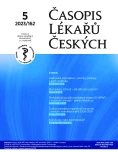Prophylactic application of closed-incision NPWT in aseptic surgery – a review of literature
Authors:
Ján Hrubovčák; Petr Jelínek; Robert Žídek; Lubomír Martínek
Authors‘ workplace:
Chirurgická klinika LF OU a FN Ostrava
Published in:
Čas. Lék. čes. 2023; 162: 207-211
Category:
Review Article
Overview
Negative pressure wound therapy is a generally accepted method of treating septic or secreting wounds. In contrast to that, postoperative application of negative pressure wound therapy to primarily closed surgical wounds is referred to as closed-incision negative-pressure wound therapy (Ci-NPWT). According to available sources, wounds after prophylactic application of Ci-NPWT show lower complication rates, especially wound infections, and dehiscence. The literature confirms that the Ci-NPWT technique improves healing of all surgical wounds, both septic and aseptic.
Keywords:
surgical site infection – Ci-NPWT – pressure therapy – aseptic wounds
Sources
- Chaffin RC. Drainage. Am J Surg 1934; 24: 100–104.
- Bagautdinov NA. Variant of external vacuum aspiration in the treatment of purulent diseases of the soft tissues. In: Volkov VY et al. (eds.). Current Problems in Modern Clinical Surgery: Interdepartmental Collection. Chuvashia State University, Cheboksary, 1986; 94–96.
- Argenta LC, Morykwas MJ. Vacuum-assisted closure: a new method for wound control and treatment: clinical experience. Ann Plast Surg 1997; 38: 563–576.
- Morykwas MJ, Faler BJ, Pearce DJ et al. Effects of varying levels of subatmospheric pressure on the rate of granulation tissue formation in experimental wounds in swine. Ann Plast Surg 2001; 47: 547–551.
- Erba P, Ogawa R, Ackermann M et al. Angiogenesis in wounds treated by microdeformational wound therapy. Ann Surg 2011; 253: 402–409.
- Scalise A, Calamita R, Tartaglione C et al. Improving wound healing and preventing surgical site complications of closed surgical incisions: a possible role of incisional negative pressure wound therapy. a systematic review of the literature. Int Wound J 2016; 13: 1260–1281.
- Mendez-Eastman S. Negative pressure wound therapy. Plast Surg Nurs 1998; 18: 27–37.
- Gombert A, Dillavou E, D'Agostino R jr. et al. A systematic review and meta-analysis of randomized controlled trials for the reduction of surgical site infection in closed incision management versus standard of care dressings over closed vascular groin incisions. Vascular 2020; 28: 274–284.
- Galiano RD, Hudson D, Shin J et al. Incisional negative pressure wound therapy for prevention of wound healing complications following reduction mammaplasty. Plast Reconstr Surg Glob Open 2018; 6: e1560.
- Fogacci T, Cattin F, Semprini G et al. The negative pressure therapy with PICO as a prevention of surgical site infection in high-risk patients undergoing breast surgery. Breast J. 2020; 26: 1071–1073.
- Gillespie BM, Webster J, Ellwood D et al. Closed incision negative pressure wound therapy versus standard dressings in obese women undergoing caesarean section: multicentre parallel group randomised controlled trial. BMJ 2021; 373: n893.
- Grauhan O, Navasardyan A, Hofmann M et al. Prevention of poststernotomy wound infections in obese patients by negative pressure wound therapy. J Thorac Cardiovasc Surg 2013; 145: 1387–1392.
- Stevens DL. Treatments for skin and soft-tissue and surgical site infections due to MDR Gram-positive bacteria. J Infect 2009; 59 (Suppl. 1): S32–S39.
- Brega C, Calvi S, Albertini A. Use of a negative pressure wound therapy system over closed incisions option in preventing post-sternotomy wound complications. Wound Repair Regen 2021; 29: 848–852.
- Wang J, Chapman Z, Cole E et al. Use of closed incision negative pressure therapy (ciNPT) in breast reconstruction abdominal free flap donor sites. J Clin Med 2021; 10: 5176.
- Moncrieff MD, Sharma RA, Gathura E, Heaton MJ. Improved perioperative seroma and complication rates following the application of a 2-layer negative pressure wound therapy system after inguinal lymphadenectomy for metastatic cutaneous melanoma. Ann Surg Oncol 2020; 27: 3692–3701.
- Poirier A, Albuisson E, Bihain F et al. Does preventive negative pressure wound therapy (NPWT) reduce local complications following lymph node dissection (LND) in the management of metastatic skin tumors? J Plast Reconstr Aesthet Surg 2022; 75: 4403–4409.
- Berner-Hansen V, Oma E, Willaume M, Jensen KK. Prophylactic negative pressure wound therapy after open ventral hernia repair: a systematic review and meta-analysis. Hernia 2021; 25: 1481–1490.
- Silverman RP, Apostolides J, Chatterjee A et al. The use of closed incision negative pressure therapy for incision and surrounding soft tissue management: Expert panel consensus recommendations. Int Wound J 2022; 19: 643–655.
- Foroutanjazi S, Jonczyk M, Chen L, Chatterjee A. Closed incision negative pressure therapy: Indications and adherence to protocol. Am Surg 2021; 87: 760–764.
- Willy C, Agarwal A, Andersen CA et al. Closed incision negative pressure therapy: International multidisciplinary consensus recommendations. Int Wound J 2017; 14: 385–398.
- Novak A, Wasim SK, Palmer J. The evidence-based principles of negative pressure wound therapy in trauma & orthopedics. Open Orthop J 2014; 27: 168–177.
Labels
Addictology Allergology and clinical immunology Angiology Audiology Clinical biochemistry Dermatology & STDs Paediatric gastroenterology Paediatric surgery Paediatric cardiology Paediatric neurology Paediatric ENT Paediatric psychiatry Paediatric rheumatology Diabetology Pharmacy Vascular surgery Pain management Dental HygienistArticle was published in
Journal of Czech Physicians

Most read in this issue
- Coloscopy, or colonoscopy?
- Biomarkers of aging – current state of knowledge
- Assisted reproduction – principles, procedures, and their effectiveness
- Change in the prevalence of overweight/obesity in Czech seven-year-old children between 2008 and 2019
